2015
2015 was a very unusual year. Let’s review it one month at a time…
January 2015
Laxmi, Dr Prakash’s wife, completed her degree in nursing.
Two SCI colleagues returned home after spending a few weeks at SIRC: Amira, an occupational therapist, returned to Canada and SCI rehab specialist physician Renee returned to Italy. Financial plan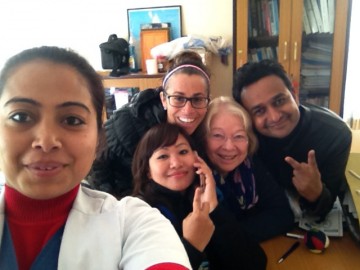 ner Kate, returned to Bowen Island.
ner Kate, returned to Bowen Island.
On the right, a photo shows (left to right) Mandira, Chanda, Amira, Renee and Uday in a group selfie taken at SIRC.
February 2015
Prakash attended a two and a half day educational course held in Chitwan, Nepal, by the Asian Congress of Neurological Surgeons. This included hands-on workshops on skull base approaches, spinal instrumentation, microvascular anastomosis and endovascular techniques. In spine, he studied anterior cervical discectomy and pedicle screw use in the lumbar vertebrae.
March 2015
In March Prakash participated in a neuroendoscopy workshop and assisted visiting Japanese Professor Shizuo Oi in the performance of endoscopic third ventriculostomy through a burrhole for hydrocephalus.
April 2015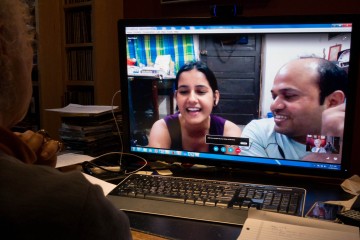
Raju began Phase B training in Dhaka, involving rotations through the different rehab services. He was joined in the Dhaka training program by another young physician, Dr Jas Bahadur Gurung, who had previously worked at the INF Green Pastures Hospital in Pokhara, Nepal. Right: Skyping with Sheela and Raju.
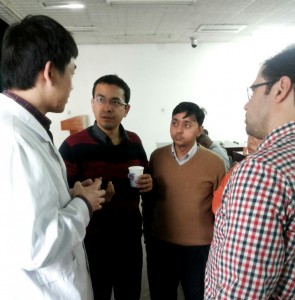 Prakash attended a one-month seminar courtesy of the Chinese government, on “Technology of Prevention and Treatment of Cerebrovascular Disease for Developing Countries, 2015”. (China, with a high incidence of stroke, has a large stroke network and registry.) He was very enthusiastic about this as we chatted on Viber two days into the course. Of four invited Nepalese neurosurgeons to Beijing for this month’s training directed at the management of stroke, Prakash was the only resident. Left: standing with his senior from Nepal as talks begin.
Prakash attended a one-month seminar courtesy of the Chinese government, on “Technology of Prevention and Treatment of Cerebrovascular Disease for Developing Countries, 2015”. (China, with a high incidence of stroke, has a large stroke network and registry.) He was very enthusiastic about this as we chatted on Viber two days into the course. Of four invited Nepalese neurosurgeons to Beijing for this month’s training directed at the management of stroke, Prakash was the only resident. Left: standing with his senior from Nepal as talks begin.
April 25….. 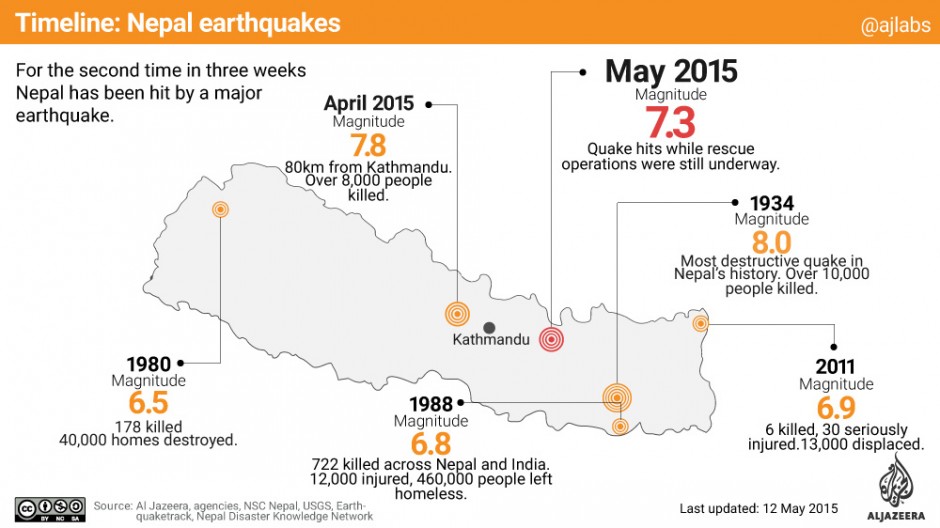
…….was a terrible day to remember in Nepal: a major earthquake, felt as far away as New Delhi and Dhaka, produced a lot of damage in the Kathmandu valley and adjacent districts. The epicentre was near Raju’s family’s village but the family was OK as most were outside working during the day. However, many buildings were destroyed.
We spoke with a number of Nepalese friends, including Prakash, still in Beijing for his course – he learned that Laxmi, his pregnant wife, was OK. Their building was standing and appeared intact. He and the other Nepali surgeons taking the Chinese course were aware that the KTM airport was closed to commercial flights until it could be inspected, after which it became very busy with arriving medical teams and relatively little space for massive cargo shipments.
Handicap International Canada agreed to add a link on their website directing donations to SIRC! Working on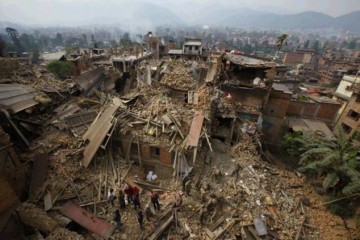 fundraising with friend and colleague Kate Coffey we suggested that our supporters direct about 70% of Canadian donations to HI Canada and 30% to our project. The HI donations were for SIRC to cover more general needs of the hospital, while donations to our project were to support medical care of the expected deluge of 50-100 new patients.By Day 4 a new spinal earthquake ward had been opened at the spinal centre, 20 new patients had been admitted and many more were on the way. Despite the fact that many patients were now under canvas as tents were erected around the hospital, additional beds, mattress, blankets, catheters, antibiotics and pain killers were being procured locally. Eleven staff members were stationed in almost all the acute centres in the Kathmandu valley, providing counseling for bowel, bladder and pressure ulcer management for people with SCI.
fundraising with friend and colleague Kate Coffey we suggested that our supporters direct about 70% of Canadian donations to HI Canada and 30% to our project. The HI donations were for SIRC to cover more general needs of the hospital, while donations to our project were to support medical care of the expected deluge of 50-100 new patients.By Day 4 a new spinal earthquake ward had been opened at the spinal centre, 20 new patients had been admitted and many more were on the way. Despite the fact that many patients were now under canvas as tents were erected around the hospital, additional beds, mattress, blankets, catheters, antibiotics and pain killers were being procured locally. Eleven staff members were stationed in almost all the acute centres in the Kathmandu valley, providing counseling for bowel, bladder and pressure ulcer management for people with SCI. 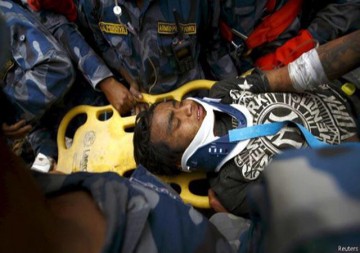
Images like these were on the Internet – collapsed buildings, injured people being evaluated to swamped hospitals and people with no shelter from the rains.
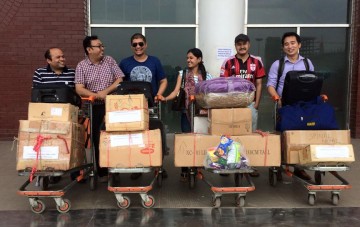 By the end of the first week, Raju’s team (right, in Dhaka airport) had taken 250 kgs of packages and cash from supportive Bangladeshi physicians, the Centre for Rehabilitation of the Paralyzed and others and been able to find a flight to Kathmandu. They began the task of assessing the needs of the new and older patients with hospitalist Dr Bishow.
By the end of the first week, Raju’s team (right, in Dhaka airport) had taken 250 kgs of packages and cash from supportive Bangladeshi physicians, the Centre for Rehabilitation of the Paralyzed and others and been able to find a flight to Kathmandu. They began the task of assessing the needs of the new and older patients with hospitalist Dr Bishow.
May 2015
Our giving sites were live, qualifying for additional contributions to Nepal (not to our project) by the Canadian government. Estimates at this stage predicted as many as 300 patients with spinal injuries that might come to SIRC. An Australian team spent several days at SIRC, and plans were made for a rotation of foreign medical teams (FMTs) to follow Raju’s team.
- Prakash was able to return from China May 2, and quickly went to work at Bir Hospital, which had finally opened its trauma wing, built five years previously but unused for obscure administrative reasons.
- At one week SIRC had received 27 people with SCI from the earthquake, with a total of 65 patients. The first patients received were paraplegics, mostly incomplete, about half men and half women. Expansion plans were to initially take the bed capacity from its usual 50 to 110.
- Experienced British SCI nurse Fiona Stephenson arrived to stay several months training newly hired Nepalese staff and coordinate FMTs; one of the first teams was from the UK.
- Supportive Spine Nepal specialists were in frequent Skype/Viber contact with Raju and the other docs as needed, reviewing cases and their imaging (below).
- On May 12 a second major quake was felt. The SIRC building was undamaged, but the many patients, injured in the first earthquake, were very frightened and moved again into the tents.
- By May 16 the patients were arranged in four acuity-related categories. No governmental funds were being received for care but direct donations from many groups were beginning to arrive.
- By later May regional and distant individuals and teams were in place to train and work alongside the SIRC staff.
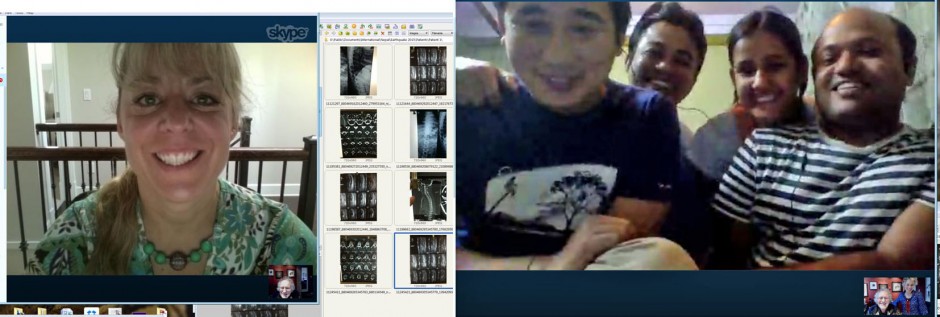
June 2015
- As of June 3, the estimate was that 500,000 homes and 36,000 school classrooms had been destroyed or damaged a enough to be unusable. 8,700 people had lost their lives,
- SIRC was up to 114 patients; rehab lead Chanda, nurses Mandira and Fiona had reorganised the patients now into 3 groups.
- Patients who came early to SIRC were much less likely to have pressure sores than those who had spent some weeks at an acute hospital.
- Dr Christine Groves (below right), a physiatrist from the US, joined the team. Dedicated to overseas health care, she had already spent a year in Nepal and was a great addition to work alongside hospitalist Dr Bishow.
- SIRC’s executive director Esha Thapa was an active participant in the Injury and Rehabilitation planning subcluster of WHO.
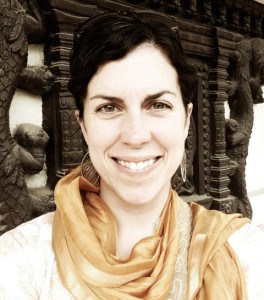
July 2015
Dr Christine Groves reported that she and Dr Bishow were “trying to reimplement things like multidisciplinary team meetings, case presentations, and other educational opportunities for the staff. Urology specialists have also resumed rounding, which is helpful. I’m impressed by how smoothly things are running at SIRC despite the reality of 110+ patients”.
The International Spinal Cord Society (ISCoS) offered to provide financial support to SIRC and to this year’s ASCoN conference special feature “International Symposium on Post Disaster Injury and Rehabilitation” on 3rd December, preceding the main ASCoN conference on 4th – 6th December. Also, the new textbook from ISCoS was to be made available to those working at SIRC thanks to ISCoS contributions and the work of editor-in-chief Dr Harvinder Chhabra, medical director of the Indian Spinal Injury Centre (ISIC). ISCoS had previously provided support to SIRC for the earthquake preparedness sessions we set up (in conjunction with SIRC and with what is now known as the Nepal Seismological Centre) in April 2012.
Dr Renee Maschke, an SCI specialist from Perugia, arrived to spend a month at SIRC.
Aug 2015
Nathan O’Hara (our logistical helper in the UBC Department of Orthoaepdics) left Vancouver for Baltimore. Nathan was instrumental in getting our organisation into reality.
Initially caught in administrative limbo, our Canadian funds were to be fully forwarded on to SIRC. Direct Relief in the US also provided a large donation to support patient care at SIRC (an amount commensurate with the larger US population).
Dr Raju was also able to return to SIRC for another two weeks, working with and learning from Dr Renee.
Sept 2015
Dr Raju was for two weeks the guest of Dr Fary Khan and her rehabilitation medicine team (one of the earliest to respond to assist at SIRC) in Melbourne, Australia. While this was not a dedicated SCI program, he was also able to visit the SCI unit at the Austin Hospital there. They generously gave him a mobility scooter and provided new braces.
Plans were in place for December’s regional Asian Spinal Cord Network annual meeting to be held, despite the earthquake problems, in Kathmandu.
Sheela was working at SIRC through the fall, analysing data.
On Sept 20th Nepal’s new constitution was passed. Many years in the making, this led to political turmoil and dissent from some ethnic groups and, within days, to a border blockade with India that continues at the time of writing (March 2016). Nepal was unable to bring in more than a minimal amount of fuel, food supply is restricted as is the importation of building supplies needed for rebuilding.
Oct 2015
SIRC was partnered with Medecins sans Frontieres to establish a program for those patients ready to leave the hospital but without inhabitable homes.
As the hospital capacity had increased to manage a greater patient population, work began on plans to expand into other areas of rehabilitation.
Several photographers visited SIRC through the months after the earthquakes, leading to a number of photographic essays. The photographers included Omar Havana , Kiran Kreer, Ian Cameron (images in the book “Memoirs” published by SIRC. (In addition, local photographer Narayan Shrestha took some excellent images of the SIRC facility using a drone views.) Place image of cover of Memoirs here.
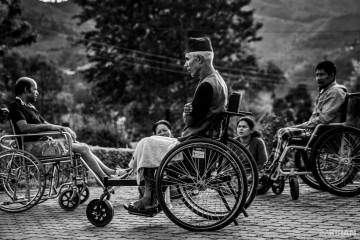
Left: “A typical day every 5pm to 6.30pm… outdoor activities, means just sitting out in the open. Some silently looking out into the world, some conversations with others making life seem normal again. Different types of wheelchairs are given to each resident. A bigger type for the harsh conditions in Nepal as the streets here are not accessible or made for wheelchairs. It’s nearly impossible to even walk on the streets without a car or motorbike knocking you down, there are accidents everyday. How would it be in a wheelchair here? How would they do this in their mountain villages?” (Photo and text by Kiran Kreer used with permission)
Nov 2015
Claire and Peter travelled to Nepal, visiting SIRC at the same time as a number of friends: Inke from Stockholm, Sweden, Colleen from Fredericton, Canada, Amira from Halifax, Canada, Kate from Bowen Island, Canada, Stanley Ducharme, Boston, USA. We were amazed at how well SIRC seemed to be doing, and how good their morale.
Purchase of a new urodynamic machine was sponsored by ISCoS. Urologic complications can be a danger to health and even life in people with spinal cord injury; careful assessment of function of the urinary tract can reduce the effect of these complications and are considered essential for a safer recovery from the injury. A workshop for those using the machine was integrated into the December ASCoN meeting, and taught by Drs Apichana Kovindha of Thailand and Jean-Jacques Wyndaele of Belgium (Spinal Cord Editor and president of ISCoS).
Stan Ducharme, a Boston-based psychologist and teacher who has travelled frequently to assist in professional development in far-eastern spinal injury centres, again visited SIRC to support the peer counsellors.
Dec 2015
The ASCoN meeting sponsored by SIRC in Kathmandu was a great success and well attended despite the ongoing difficulties related to the Blockade.
This was our first visit to Nepal since the earthquakes. SIRC had managed so well over the last few months, helped by many people, some we know and some we have never met, from all around the world. Some sent teams, some sent money and/or equipment, some offered knowledge and advice, but the SIRC staff and their friends have made it all work. Here are a few of our observations.
General impressions:
- Perhaps surprisingly, life continues despite earthquakes and despite the fuel blockade. Even weddings go on (this was an auspicious time of year for weddings): Nepalese weddings, Hindu or Newari, are generous, open social affairs, offering food and company to friends and family alike – we attended two in our first two days (a lovely surprise on arriving!)
- More buildings were standing than we expected. Contemporary urban houses in Kathmandu, mostly reinforced concrete in construction, developed a few cracks but seem largely to have remained inhabitable. Older buildings in Kathmandu had partially or totally disintegrated. Fortunately, some of the historic temples that we were sure would have fallen remain sound; others crumbled or fell. We know that the homes built of dry stone walls in the rural areas had done badly, with over 90% damaged in some districts – one of the worst being Sindhupalchowk just north of SIRC, where many of our patients came from.
- Rebuilding had stagnated and at six months after the major quakes, only 13.5% of the pledged funds from overseas had been used and many families were ill-prepared for winter. We saw a number of tent cities, the tents now aging and weathered from the monsoons, still being the only homes for many. This delay is stated to be due to the border blockade – we do not have space here to detail this here. The image on the right shows the congestion by the buses queuing on the right as they waited (often days) for diesel fuel from a filling station in the distant village.
- A young schoolteacher, friend of the Jorpati tailor who was making up some shirts for our family, had lost six family members in his birth village, some kilometres north of Kathmandu. There are of course many more with similar stories of loss of homes and loved ones.
- The Nepalese have shown great resilience as they deal with this year’s problems. The staff of SIRC appeared to be doing very well. Several had house damage but none had lost family. There are a number of strong leaders and many, many new faces as the number of staff swelled.
- Founding Board Chair Kanak Mani Dixit credited the hospital staff with their superb response to the earthquake. 144 people with spinal injuries were admitted, nearly all with SCI, as a result of the quake – plus SCI from the usual causes who also needed the services of SIRC.
- Executive director Esha Thapa led SIRC’s response with her usual flair, collaborating with Nepalese and overseas teams as the size and scope of the hospital’s mission grew this year. She has done an amazing job.
- Most of the tents used to house patients in the summer have now been taken down with just one remaining, which is used as a kid’s tent (right) for children of families in the hospital. Finishing touches were being placed to a second floor building expansion courtesy of MSF Belgium, to act as a half-way house for those with no home ready for their discharge.
- The kitchen staff have often had no propane for cooking and have prepared food over open wood fires at the back of the hospital.
- Coordination of visiting Foreign Medical Teams (FMTs) has been skilfully performed by UK SCI nursing star Fiona Stephenson, who is also an excellent teacher – a vital role considering the number of new staff. Fiona identified the needed skill sets, the logistical requirements and the optimum time for the teams to work at SIRC. Fiona, with a wonderful balance of leadership cool and the warmest of hearts prepared this wonderful composite photograph of some of the many people who have assisted SIRC during her time there (right).
- Livability. a UK organisation working in Asia for 20 years, has been a supporter of SIRC since 2002. Stephen Muldoon (who brought us in to assist with training) has visited several times since the earthquakes.
- SIRC’s business managers have responded well as new programs have been developed with Bowen Island’s Kate Coffey mentoring the younger business staff. Kate was there when we visited, and continues to provide useful insights through her Bowen2Bangladesh blog.
- Rehabilitation Medicine is finally being recognised in Nepal as a major need for injured people, and SIRC is a major member of the planning process through the earthquake cluster system and the Nepalese Ministry of Health.
A small booklet “Memoirs” documents some of the many people with SCI who have lived and/or worked at SIRC this year – thanks to Vancouver photographer Ian Cameron.
Recent developments:
The conference that drew us (and many colleagues) back at this time was the Asian Spinal Cord Network annual meeting: ASCON 2015. In our view it was a gamble that really worked. We were amazed that Esha, Archana, Nikita and the Muldoons were able to pull it all together, with about 250 attendees. There were policy planning meetings, an afternoon on which we heard of the amazing work done by SIRC and other hospitals, and general SCI-related papers. One day was spent up at SIRC with a tour of the facility, a wheelchair sports day and several workshops.
Current visitors/volunteers to SIRC included a number of friends. We mentioned Fiona, Steve and Maggie, already. Dr Jean-Jacques Wyndaele, International Spinal Cord Society (ISCoS) president and editor of Spinal Cord, attended the meeting and (with Dr Apichana Govindha from Thailand) taught the urodynamics workshop. Dr Wyndaele is seen (above right) with administrator Dipesh and Dr Raju outside the hospital; the patients’ exercise session in the background. Drs Colleen O’Connell from Fredericton, Taslim Uddin from Dhaka (Raju’s chief), Ruth Marshall from Adelaide and Ron Reeves from the US taught in workshops. Prof Lisa Harvey ran a well-attended physiotherapy workshop. Physiotherapist Inka Lofvenmark nearing completion of her PhD in Stockholm (Peter is one of her examiners) was beginning a several-week visit. Dr Stanley Ducharme, psychologist, has long been involved in developing necessary psychological services in spinal cord units throughout Asia, and launched new guidelines at this meeting. Dr Renee Maschke, a SCI specialist from Perugia, was there for her fourth visit and is offering teaching and professional support to Drs Sushil and Bishow, young physicians currently working in patient care at SIRC. Dr Christine Groves continues to support a high level of care but was away during our stay. Kate Coffey was in attendance and hopes to return again for a longer stay later in 2016 – great work, K ate!
Dr Prakash and Laxmi became proud parents (left). Prakash finishes his training in Kathmandu soon. Laxmi left with their daughter to spend time with her mother, as Prakash prepares to sit his final neurosurgery exams, following which he will begin a three month observership in Dr Chhabra’s spinal unit in New Delhi. Dr Chhabra, teaching and promoting the new ISCoS textbook, met at ASCON with Prakash to discuss his research topic. On the right, Dr Chhabra presents Dr Raju with a copy of the ISCoS textbook with (left to right) Esha Thapa, Drs Claire, Renee, Peter and Raju’s teacher Dr Taslim Uddin.
Sheela and (SIRC nurse) Durga presented their review of patient data at the ASCON meeting. Christine, Sushil and Bishow reviewed and presented SIRC’s experience with quake-caused spinal injuries. Dr Wyndaele recommended that both these studies be prepared for journal publication.
In summary – this was both a terrible and a wonderful year. Nepal remains a wild and beautiful country. Major earthquakes took their toll this year, but SIRC was well placed to perform its work. It was reasonably well prepared beforehand, and responded accurately and quickly, with help from its many friends. We are proud to have been associated with them and we hope that all of you feel able to share the pride of what has been and still is being achieved. Many donors, including you, have generously responded with financial gifts through Handicap International Canada, Spine Nepal, Direct Relief and other organisations. Thank you for your ongoing support.
On to 2016!